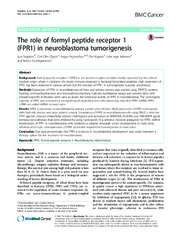| dc.contributor.author | Snapkov, Igor | |
| dc.contributor.author | Öqvist, Carl Otto | |
| dc.contributor.author | Figenschau, Yngve Anton | |
| dc.contributor.author | Kogner, Per | |
| dc.contributor.author | Johnsen, John Inge | |
| dc.contributor.author | Sveinbjørnsson, Baldur | |
| dc.date.accessioned | 2017-02-28T16:15:23Z | |
| dc.date.available | 2017-02-28T16:15:23Z | |
| dc.date.issued | 2016-07-18 | |
| dc.description.abstract | Background: Formyl peptide receptor 1 (FPR1) is a G protein-coupled receptor mainly expressed by the cells of
myeloid origin, where it mediates the innate immune response to bacterial formylated peptides. High expression of
FPR1 has been detected in various cancers but the function of FPR1 in tumorigenesis is poorly understood.
Methods: Expression of FPR1 in neuroblastoma cell lines and primary tumors was studied using RT-PCR, western
blotting, immunofluorescence and immunohistochemistry. Calcium mobilization assays and western blots with
phospho-specific antibodies were used to assess the functional activity of FPR1 in neuroblastoma. The tumorigenic
capacity of FPR1 was assessed by xenografting of neuroblastoma cells expressing inducible FPR1 shRNA, FPR1
cDNA or control shRNA in nude mice.
Results: FPR1 is expressed in neuroblastoma primary tumors and cell lines. High expression of FPR1 corresponds
with high-risk disease and poor patient survival. Stimulation of FPR1 in neuroblastoma cells using fMLP, a selective
FPR1 agonist, induced intracellular calcium mobilization and activation of MAPK/Erk, PI3K/Akt and P38-MAPK signal
transduction pathways that were inhibited by using Cyclosporin H, a selective receptor antagonist for FPR1. shRNA
knock-down of FPR1 in neuroblastoma cells conferred a delayed xenograft tumor development in nude mice,
whereas an ectopic overexpression of FPR1 promoted augmented tumorigenesis in nude mice.
Conclusion: Our data demonstrate that FPR1 is involved in neuroblastoma development and could represent a
therapy option for the treatment of neuroblastoma. | en_US |
| dc.description | Published version. Source at <a href=http://dx.doi.org/10.1186/s12885-016-2545-1> http://dx.doi.org/10.1186/s12885-016-2545-1 </a> | en_US |
| dc.identifier.citation | Snapkov I. et.al.: The role of formyl peptide receptor 1 (FPR1) in neuroblastoma tumorigenesis. BMC Cancer. 2016;16:490 | en_US |
| dc.identifier.cristinID | FRIDAID 1368648 | |
| dc.identifier.doi | 10.1186/s12885-016-2545-1 | |
| dc.identifier.issn | 1471-2407 | |
| dc.identifier.uri | https://hdl.handle.net/10037/10394 | |
| dc.language.iso | eng | en_US |
| dc.publisher | BioMed Central | en_US |
| dc.relation.journal | BMC Cancer | |
| dc.rights.accessRights | openAccess | en_US |
| dc.subject | Inflammation | en_US |
| dc.subject | Neuroblastoma | en_US |
| dc.subject | Formyl peptide receptor 1 | en_US |
| dc.subject | FPR1 | en_US |
| dc.subject | VDP::Medical disciplines: 700::Clinical medical disciplines: 750 | en_US |
| dc.subject | VDP::Medisinske Fag: 700::Klinisk medisinske fag: 750 | en_US |
| dc.title | The role of formyl peptide receptor 1 (FPR1) in neuroblastoma tumorigenesis | en_US |
| dc.type | Journal article | en_US |
| dc.type | Tidsskriftartikkel | en_US |
| dc.type | Peer reviewed | en_US |


 English
English norsk
norsk